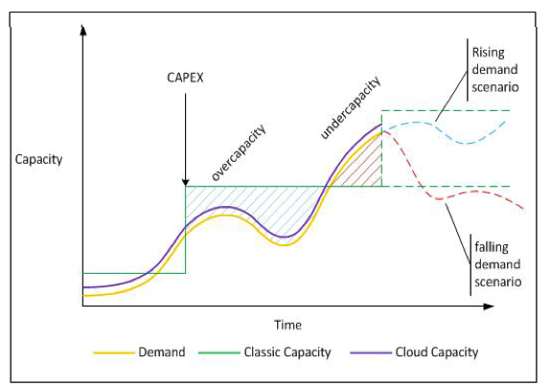IaaS-cases: How the "cloud" helps the business

Last week we presented one of our new books with technical and economic calculations to justify the introduction of cloud technologies at the level of virtual infrastructure. Today we decided to give examples of real business case studies with IaaS.
“The process of adapting cloud technologies is rapidly gaining momentum, and there are no prerequisites for the opposite,” said Daryl Plummer, an analyst at Gartner. Indeed, the term “cloud technologies” is widely known all over the world, and today we decided to talk about why companies make a choice towards this technology.
')
Today, many organizations prefer IaaS, bypassing the purchase of their own hardware and software. An example of this is the Speech Technology Center, which has moved to the cloud due to the wide opportunities provided by servicing a large number of users without delay. The company leases the virtual servers needed to test and implement external high-availability projects.
One of the company's products is VoiceFabric speech synthesis cloud service, which allows you to synthesize speech directly on the site or using an API key embedded in a web request. The company has learned to create unique voices, as well as to recreate the voices of real people, for example, the voice of Yuri Mikhailovich Yuryev.
MDG experts also participated in the development of a voice virtual consultant named “Elena” of Megafon. This virtual employee is able to determine the topic of the appeal, answer questions and request the necessary additional information. Now, Yandex uses algorithms for speech recognition, and the MDGs are responsible for voice formation and speech synthesis.
Another example of a company that has switched to the use of cloud technologies is the highly loaded Hotels.ru hotel reservation service, which several years ago transferred part of its infrastructure to the IaaS cloud of IT-GRAD. This was done because the base of the Hotels.ru project for the year grows by about 50%, and cloud technologies were able to offer easy infrastructure scaling and high performance.
The online booking market is very competitive, and in order not to lose its positions, Hotels.ru has to constantly improve its service, refine its front-end and optimize its internal systems. Do not do without the comparative tests of various ideas.
According to the members of the Hotels.ru team, they no longer need to bother with self-assembling servers and spend the nights putting them into operation - just a couple of clicks are enough, and the farm is ready for the tests.
It is worth noting that the clouds are gaining popularity due to two main advantages. The first is to save money. The Boston Consulting Group (BCG) developed the concept of an “overall efficiency growth” curve, showing how production costs change with an increase in the number of units of output.
From the graph it follows that the cost of production decreases with an increase in the volume of output. This trend is also true for the cloud industry.

Nicholas Carr, in his book The Big Switch, writes that systems that are under the control of organizations imply significant capital investments and high fixed costs. “This leads to redundancy in terms of both technology and labor,” writes Carr.
From this follows the second reason for the popularity of clouds - a flexible service model. In the work of many companies from time to time there are situations associated with bursts of user activity - these can be seasonal bursts (annual holidays) or unpredictable sharp downloads of traffic. Therefore, it is important to prepare for them in advance.
In the traditional approach, when planning production capacities, the main costs are spent on reserving additional rack space, new servers and equipment. Following this path, companies face significant financial costs even at the start. Moreover, since the peak loads are variable (they are peak), the equipment purchased is often idle.
And again at this moment the cloud comes to the rescue. This infrastructure makes it possible to attract additional resources and, if necessary, to run an unlimited number of virtual machines to cover traffic spikes. The chart below demonstrates this idea.

The green line represents the capacity of the local infrastructure. In this case, there is a surplus (shortage) of production capacity. The purple line, which almost repeats the demand curve (yellow), is the power of the cloud infrastructure. Here, computing resources are allocated exactly to the extent in which it is needed - no more, no less.
Doubts are in the air ...
At a time when small businesses use cloud outsourcing with ease, big business is wary of the issue of moving to the cloud. Daryl Plummer agrees that, although interest in cloud technologies is high enough, for large companies, moving to the cloud is a long process.
According to a study conducted by Gartner, 90% of organizations surveyed are already working with some cloud technologies, and 78% want to increase the budgets spent on clouds by 2017. However, despite this, clouds make up only 4% of all IT costs. Company executives only got their feet wet in a cloud computing lake, but they are still afraid to dive into it headlong.
Fears are primarily related to the organization of the work of applications and ensuring an adequate level of security. However, the providers of cloud services for quite a long time used the necessary certified means of information protection. For example, in the IT-GRAD cloud, the SCAT DPI-based DDoS protection service is implemented , using the technology of in- depth traffic analysis, and SecureCloud technology is used to provide encryption in the cloud.
Another stumbling block on the way to move to the cloud by large companies is the organization of secure access of a large number of users. However, there is a solution here - the implementation of secure single sign-on (SSO).
Interacting through a federated web-based SSO environment can help create more efficient and secure online operations between organizations united by a federation trust relationship. The principle of operation can be explained on the example of a company supplying auto parts.
Suppose a company has a web application that allows dealers to purchase goods at wholesale prices and is located in the cloud of an IaaS provider. The provider wants to organize secure access to the web service, identifying users authorized to place an order.
Previously, the issue was resolved as follows: a database was created with user accounts on the side of the company hosting the infrastructure in the cloud, where user names and passwords were stored. This is quite a working option, but with a large number of records, tracking the relevance of the data turns into a headache.

The federation services, on the other hand, allow you to establish trust relationships, moving away from the model of creating user accounts on the side of a company that provides access to resources. In this case, an agent is installed on the client side. When a user from a dealer accesses the site of the supplier company, the browser is redirected to the dealer site, and authentication is performed.
After that, the browser is returned to the partner site providing the resources, and the new request contains a “statement” of the trusted side of the dealer organization, which says that the user is indeed an employee of the dealer organization and has the right to buy parts.
Thus, within the framework of a federated cloud, even a small service provider can offer a truly global service, without spending huge sums on the construction of a new infrastructure. You just need to understand the concepts inherent in the clouds and know how to use the right tools.
PS Other interesting materials on the topic:
- Technical and economic calculations to justify the introduction of cloud technologies
- IaaS provider and security issues
- Firewalls Palo Alto Networks VM-Series
- The most interesting of the vSphere 6 arsenal
- Projects "moved" to the cloud: IT-GRAD's company experience
- PCI DSS Certification: What it is and what it is eaten with
Source: https://habr.com/ru/post/281805/
All Articles